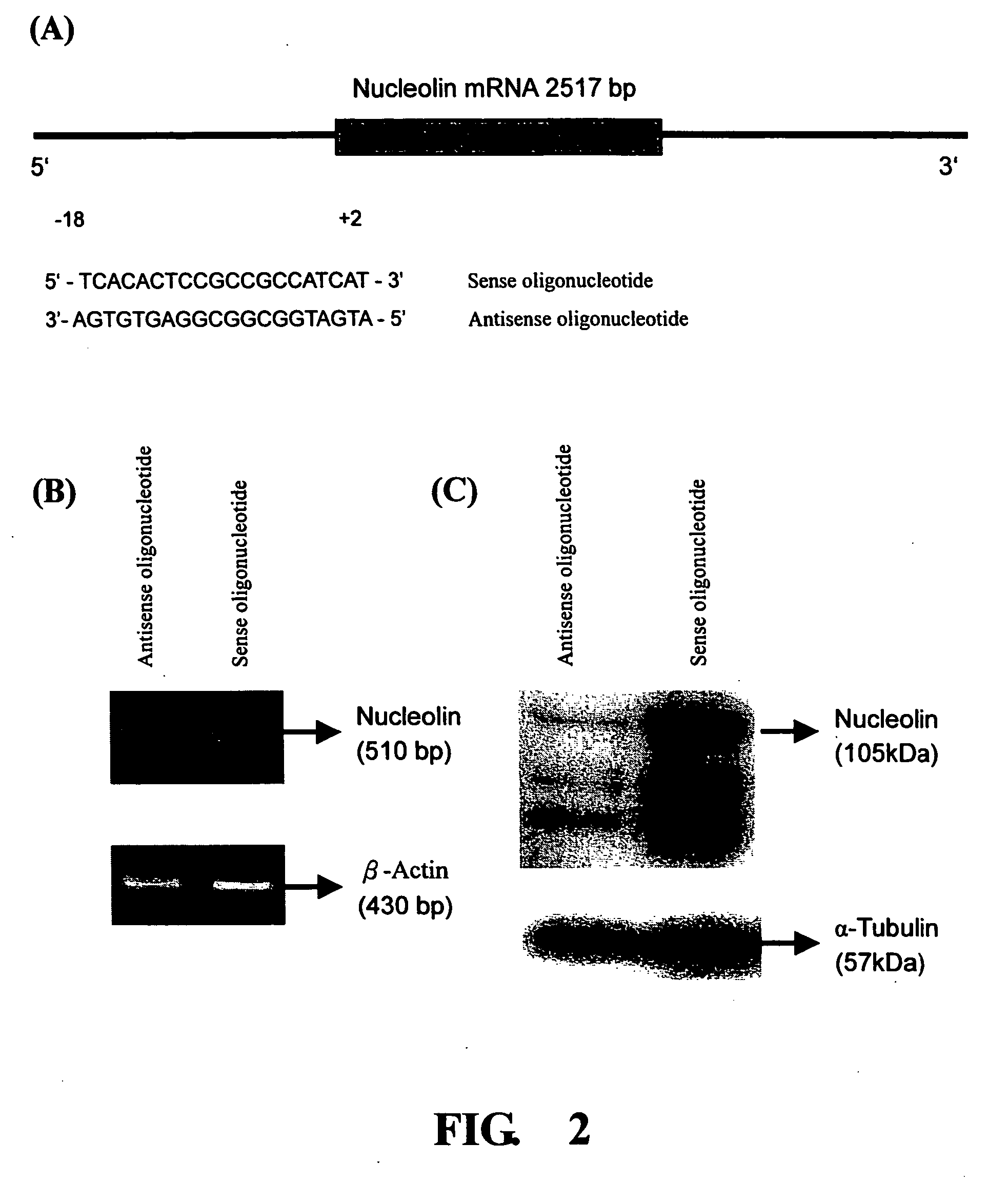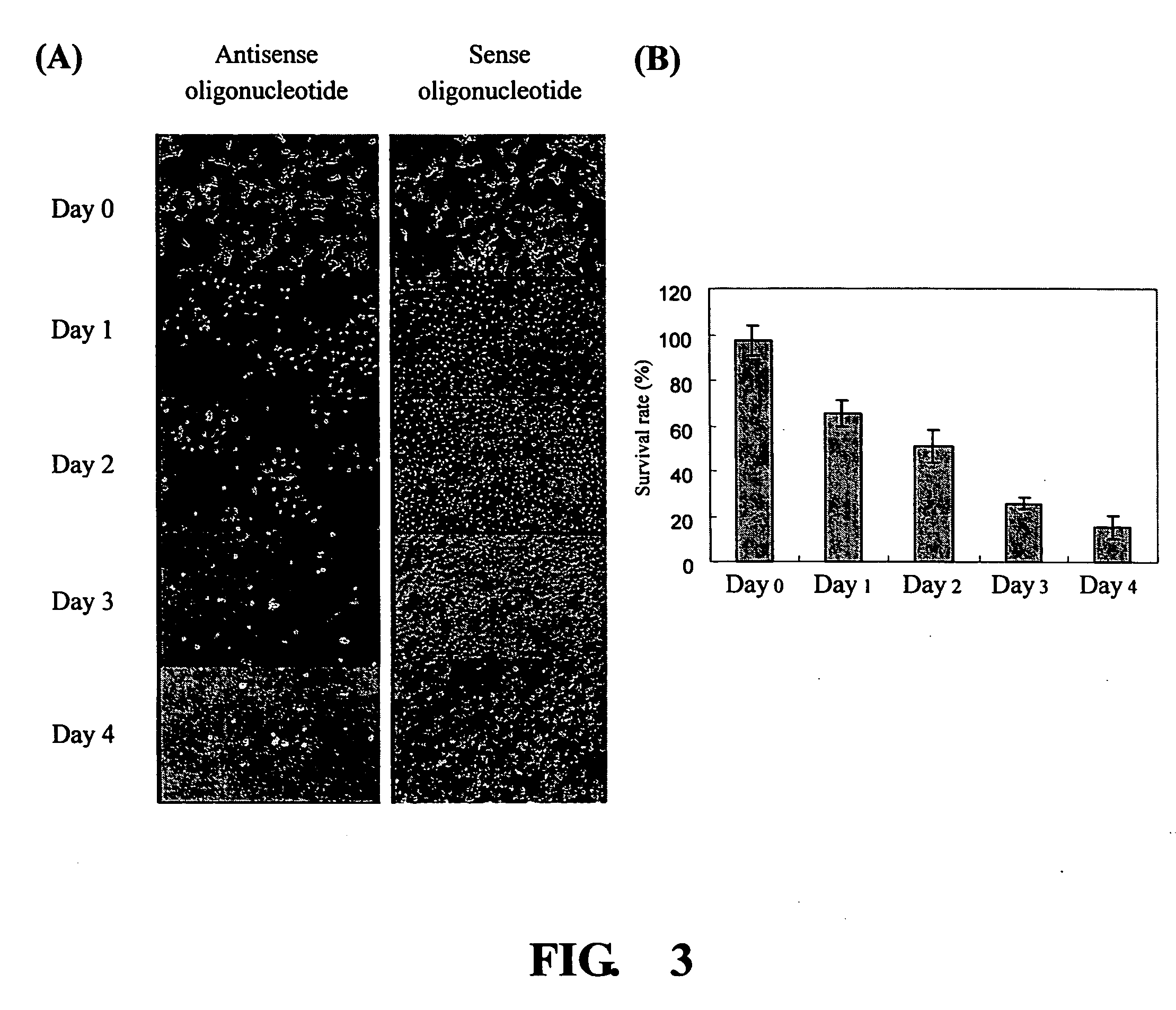Nucleolin antisense sequence for inhibition of cancer cell proliferation
- Summary
- Abstract
- Description
- Claims
- Application Information
AI Technical Summary
Benefits of technology
Problems solved by technology
Method used
Image
Examples
example 1
[0048] Nucleolin Antisense Oligonucleotide on Suppression of Nucleolin Expression
[0049] Based on the sequence of nucleolin mRNA, the inventor designs a specific nucleolin antisense sequence (SEQ ID NO:1) and synthesizes the sequence using Sigma Genosys. Nucleolin sense oligonucleotide (SEQ ID NO:2) is also synthesized for control experiment.
[0050] Treansfection of the sense / antisense S-oligos (250 nM) is carried out by using transfection reagent Oligofectamine as a vector. Before transfection, NPC-TW01 cells and NNM cells are cultivated in 6-well plates at a density of 5×104 cells for 24 hours. The transfection mixture is prepared in Opti-MEM containing 4 μl Oligofectamine per 250 nM oligonucleotide according to the manufacturer's instructions. Transfection is allowed to carry out for 4 hours after the addition of the transfection mixture in a final volume of 1 ml per well. Then, 10% fetal calf serum medium is added without removing the transfection mixture. Nucleolin RNA and the ...
example 2
[0052] Analysis of Growth Inhibitory Effect of Nucleolin Antisense on Tumor Cells by MTT Assay
[0053] Tumor cells at density of 4×103 cells are incubated in 96-well microplates and allowed to grow overnight. Tumor cells are then treated with nucleolin antisense S-oligos for 12, 24, and 48 hours. After treatment, 100 μl of 2 mg / ml MTT in DMEM containing 5% of FBS serum is added to each well, followed by incubation for 2.5 hours at 37° C. The formazan crystals then dissolved in DMSO. The absorbance is determined with a reader at 540 nm. Absorbance values are normalized to the values obtained for the sense oligonucleotides-treated cells to determine the percentage of survival. Each assay is performed in triplicate.
[0054] The results show that after nucleolin antisense treatment, tumor cell growth is suppressed and its effectiveness is time dependent (FIG. 3(B)), while the NNM cells show no or only little suppression of cell growth.
example 3
[0055] The Inhibitory Effect of Antisense S-oligos on Tumor Cell Proliferation in vivo
[0056] SCID mice (female, 4-6 weeks old) are purchased from National Taiwan University Hospital Laboratory Animal Center and accommodated for 7 days for environmental adjustment before study. Cultured NPC TW-01 cells are trypsinized, resuspended in serum-free DMEM and then injected s.c. (subcutaneous injection) (1×107 cells, total volume 0.2 ml) into the mice.
[0057] When the implanted NPC-TW01 tumor cells in the mice grow into lump of a size approximately 80-100 mm3, mice are weighed and treated with the nucleolin sense / antisense S-oligos or phosphate buffer solution, respectively, by i.v. injection (10 mg / kg weight) every two days. Growth of tumor size and body weight of the mice are observed for 35 days.
[0058]FIG. 4(A) shows that tumor volume of the nucleolin antisense S-oligos treated mice is suppressed, meanwhile no inhibitory effect of tumor growth is detected in sense S-oligos or phosphate...
PUM
| Property | Measurement | Unit |
|---|---|---|
| Size | aaaaa | aaaaa |
| Therapeutic | aaaaa | aaaaa |
| Cell proliferation rate | aaaaa | aaaaa |
Abstract
Description
Claims
Application Information
 Login to View More
Login to View More - R&D
- Intellectual Property
- Life Sciences
- Materials
- Tech Scout
- Unparalleled Data Quality
- Higher Quality Content
- 60% Fewer Hallucinations
Browse by: Latest US Patents, China's latest patents, Technical Efficacy Thesaurus, Application Domain, Technology Topic, Popular Technical Reports.
© 2025 PatSnap. All rights reserved.Legal|Privacy policy|Modern Slavery Act Transparency Statement|Sitemap|About US| Contact US: help@patsnap.com



